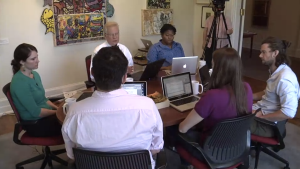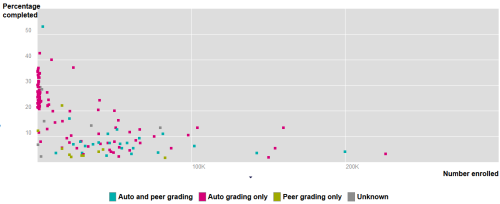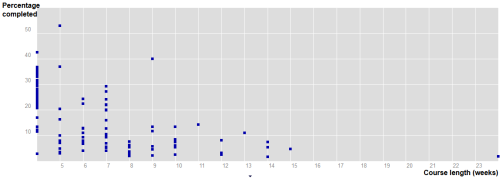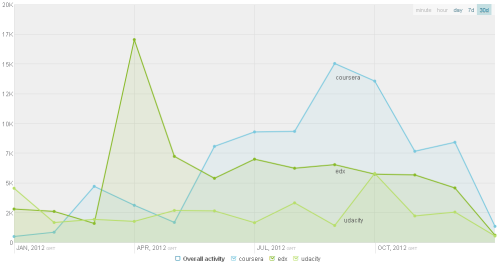I’ve been meaning to jot down my notes on the E-Learning and Digital Cultures (EDCMOOC) course for some time; last week, the University of Edinburgh published a detailed report on their Spring 2013 Coursera offerings, which has given me a bit of a prod to write this post.
The course began on 28th January, and ran for 5 weeks. In a sense, it had begun before the start date, as the course team had encouraged students to connect through social media channels in preparation. This had passed me by though as I’d not been paying enough attention to the pre-course emails. It seemed like a nice idea, but on the morning of the 28th when the course formally began, I was a little taken aback by a tweet:

I was a bit troubled by the view that there were already two groups of students, and a perception that the mass of students who had not engaged in the pre-course (including myself) might spoil it for those who were already engaged. It nearly put me off the course right from the start, but I couldn’t resist having a look at the course content which looked too interesting to miss, so I got stuck in.
Somewhere between a cMOOC and an xMOOC
From the word go, this course was a bit different to my previous Coursera experiences, in the following ways:
- There were no video lectures; rather, the course material included videos from other sources via YouTube, and reading materials.
- There wasn’t just one professor at the helm, but a team of five academics.
- All the course materials were made available from the start, not by weekly release of content.
- No weekly assessments – in fact no quizzes at all. The course was entirely assessed by a single peer-graded assignment, the creation of a ‘digital artefact’ in relation to the course themes. The grading rubric was also fairly open to interpretation.
- Strongly encouraged to interact with other students and have discussions – be it via the forums or any social media channels.
Initially, this was a bit disorienting – not because I prefer video lectures and linear progression, but simply because that is what I’ve become used to from my experiences with Coursera so far. However, it was easy to adjust and having the extra flexibility through the materials being ‘live’ from the start and not having weekly deadlines made it much easier for me to fit the course around my other time commitments.
There were some limitations with this arrangement though. Some students pointed out that YouTube videos aren’t accessible in all countries, and you can’t download the videos to watch offline like you can with most Coursera video lectures. It was also easy to feel overwhelmed by the volume of social media postings related to the course. Although I didn’t contribute much to the social media discussions, I did find it useful to dip in to the Twitter chat every so often. Across the various communication channels, the course team were quite active in answering questions and contributing to discussions, which was helpful. In this sense, there was much more of a tutor presence despite not having video lectures.
Digital artefacts and assessment
I chose the topic of learning analytics for my digital artefact, as I thought it offered a lot of potential to be set up in terms of the utopia/dystopia course theme. To make my artefact I used Thinglink, a tool for creating interactive images, which I had not used before but had been introduced to through the course. If you’d like to have a look at my digital artefact, it can be found here. From the small proportion of artefacts that I saw (approximately 2,000 artefacts were submitted), the diversity was fascinating; a collection of digital artefacts from the course can be found here.
The digital artefact was a very different assessment model to any of the other MOOCs that I’ve taken to date. It was ‘all or nothing’ – gaining a certificate for the course rested entirely on this one piece of work. However, this pressure was tempered by the fact that as long as you submitted an artefact and carried out peer assessments, you would get a certificate regardless of how your artefact fared in the assessment process.
Given the emphasis that had been placed on participation rather than assessment throughout the course, and that the grading rubric only allowed artefacts to be scored out of 2 (yes, really – 0, 1 or 2 was the range), I was surprised when the course team announced after the peer grading exercise that students with a median score of 1.5 or higher would receive a Statement of Accomplishment with Distinction.
The digital artefact submission process had potential for some security issues, as all you had to submit in Coursera was a hyperlink to your artefacts’ public location online. There is nothing but the honour code stopping students from submitting a hyperlink to anything, whether they made it or not. When the next iteration of the course takes place, there will be an existing body of digital artefacts, hashtagged and easy to find, ‘out there’ already. Two things which could reduce the potential for plagiarism might be: (i) for the platform to record the previously submitted URLs and not allow duplicate submissions; (ii) for students to also submit a short reflective text about their artefact and what they were seeking to achieve (this would also assist in the peer grading process, as some students felt their work had been misinterpreted).
When the certificates were issued, I was also struck by the phrasing of the course description:

It was the inclusion of the bit about it being an “introductory undergraduate-level course” that I found interesting. None of my other Coursera certificates include any statements about the level of the material, and I’d thought throughout that it was essentially a ‘taster’ of the Edinburgh E-learning MSc course.
Final thoughts
For me, the course had its ups and downs, but it was definitely a worthwhile experience overall due to the compelling topics and enthusiasm of the course team. Having a team rather than a single academic I suspect was key to the success of this course structure (but possibly made it more expensive to run?). The emphasis of the course was placed on the ‘digital cultures’ rather than the ‘e-learning’ bit; the course could be improved by readdressing this balance as it left me wishing there had been ‘a bit more’. But maybe that’s the idea 😉















